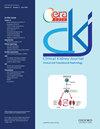Recognition patterns of acute kidney injury in hospitalized patients
IF 3.9
2区 医学
Q1 UROLOGY & NEPHROLOGY
引用次数: 0
Abstract
Background and Objectives Acute Kidney Injury (AKI) during hospitalization is associated with increased complications and mortality. Despite efforts to standardize AKI management, its recognition in clinical practice is limited. Methods To assess and characterize different patterns of AKI diagnosis, we collected clinical data, serum creatinine (sCr) levels, comorbidities, and outcomes from adult patients using the Hospital Discharge Form (HDF). AKI diagnosis was based on administrative data and according to KDIGO criteria by evaluating sCr variations during hospitalization. Additionally, patients were also categorized based on the timing of AKI onset. Results Among 56 820 patients, 42 900 (75.5%) had no AKI, 1 893 (3.3%) had AKI diagnosed by sCr changes and coded in HDF (Full-AKI), 2 529 (4.4%) had AKI reported on HDF but not meeting sCr-based criteria (HDF-AKI), and 9 498 (16.7%) had undetected AKI diagnosed by sCr changes but not coded in HDF (KDIGO-AKI). Overall, AKI incidence was 24.5%, with a 68% undetection rate. Patients with KDIGO-AKI were younger, had a higher proportion of females, lower comorbidity burden, milder AKI stages, more frequent admissions to surgical wards, and lower mortality compared to Full-AKI. All AKI groups had worse outcomes than those without AKI, and AKI, even if undetected, was independently associated with mortality risk. Patients with AKI at admission had different profiles and better outcomes than those developing AKI later. Conclusions AKI recognition in hospitalized patients is highly heterogeneous, with a significant prevalence of undetection. This variability may be affected by patients ‘characteristics, AKI-related factors, diagnostic approaches, and in-hospital patient management. AKI remains a major risk factor, emphasizing the importance of ensuring proper diagnosis for all patients.住院患者急性肾损伤的识别模式
背景和目的 住院期间的急性肾损伤(AKI)与并发症和死亡率的增加有关。尽管已在努力实现 AKI 管理的标准化,但临床实践中对 AKI 的认识仍然有限。方法 为了评估 AKI 诊断的不同模式并确定其特征,我们使用出院表(HDF)收集了成年患者的临床数据、血清肌酐(sCr)水平、合并症和预后。AKI 诊断基于管理数据,并根据 KDIGO 标准评估住院期间的 sCr 变化。此外,还根据 AKI 发病时间对患者进行了分类。结果 在 56 820 例患者中,42 900 例(75.5%)无 AKI,1 893 例(3.3%)通过 sCr 变化诊断出 AKI 并在 HDF 中进行了编码(Full-AKI),2 529 例(4.4%)在 HDF 中报告了 AKI,但不符合基于 sCr 的标准(HDF-AKI),9 498 例(16.7%)通过 sCr 变化诊断出未发现的 AKI,但未在 HDF 中进行编码(KDIGO-AKI)。总体而言,AKI 发生率为 24.5%,未检出率为 68%。与Full-AKI相比,KDIGO-AKI患者更年轻,女性比例更高,合并症负担更轻,AKI分期更轻,更常入住外科病房,死亡率更低。与无 AKI 患者相比,所有 AKI 组患者的预后都更差,而且 AKI 即使未被发现,也与死亡风险独立相关。入院时发生 AKI 的患者与后来发生 AKI 的患者相比,情况不同,预后更好。结论 住院患者对 AKI 的识别存在很大差异,未被发现的情况非常普遍。这种差异性可能受到患者特征、AKI 相关因素、诊断方法和院内患者管理的影响。AKI 仍然是一个主要的风险因素,这就强调了确保对所有患者进行正确诊断的重要性。
本文章由计算机程序翻译,如有差异,请以英文原文为准。
求助全文
约1分钟内获得全文
求助全文
来源期刊

Clinical Kidney Journal
Medicine-Transplantation
CiteScore
6.70
自引率
10.90%
发文量
242
审稿时长
8 weeks
期刊介绍:
About the Journal
Clinical Kidney Journal: Clinical and Translational Nephrology (ckj), an official journal of the ERA-EDTA (European Renal Association-European Dialysis and Transplant Association), is a fully open access, online only journal publishing bimonthly. The journal is an essential educational and training resource integrating clinical, translational and educational research into clinical practice. ckj aims to contribute to a translational research culture among nephrologists and kidney pathologists that helps close the gap between basic researchers and practicing clinicians and promote sorely needed innovation in the Nephrology field. All research articles in this journal have undergone peer review.
 求助内容:
求助内容: 应助结果提醒方式:
应助结果提醒方式:


